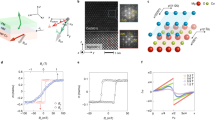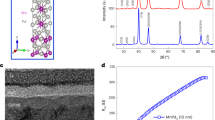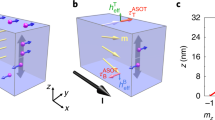Abstract
Recent demonstrations of magnetization switching induced by in-plane current injection in heavy metal/ferromagnetic heterostructures have drawn increasing attention to spin torques based on orbital-to-spin momentum transfer. The symmetry, magnitude and origin of spin–orbit torques (SOTs), however, remain a matter of debate. Here we report on the three-dimensional vector measurement of SOTs in AlOx/Co/Pt and MgO/CoFeB/Ta trilayers using harmonic analysis of the anomalous and planar Hall effects. We provide a general scheme to measure the amplitude and direction of SOTs as a function of the magnetization direction. Based on space and time inversion symmetry arguments, we demonstrate that heavy metal/ferromagnetic layers allow for two different SOTs having odd and even behaviour with respect to magnetization reversal. Such torques include strongly anisotropic field-like and spin transfer-like components, which depend on the type of heavy metal layer and annealing treatment. These results call for SOT models that go beyond the spin Hall and Rashba effects investigated thus far.
This is a preview of subscription content, access via your institution
Access options
Subscribe to this journal
Receive 12 print issues and online access
$259.00 per year
only $21.58 per issue
Buy this article
- Purchase on Springer Link
- Instant access to full article PDF
Prices may be subject to local taxes which are calculated during checkout





Similar content being viewed by others
References
Chappert, C., Fert, A. & Van Dau, F. N. The emergence of spin electronics in data storage. Nature Mater. 6, 813–823 (2007).
Brataas, A., Kent, A. D. & Ohno, H. Current-induced torques in magnetic materials. Nature Mater. 11, 372–381 (2012).
Ralph, D. C. & Stiles, M. D. Spin transfer torques. J. Magn. Magn. Mater. 320, 1190–1216 (2008).
Chernyshov, A. et al. Evidence for reversible control of magnetization in a ferromagnetic material by means of spin–orbit magnetic field. Nature Phys. 5, 656–659 (2009).
Miron, I. M. et al. Current-driven spin torque induced by the Rashba effect in a ferromagnetic metal layer. Nature Mater. 9, 230–234 (2010).
Pi, U. H. et al. Tilting of the spin orientation induced by Rashba effect in ferromagnetic metal layer. Appl. Phys. Lett. 97, 162507 (2010).
Fang, D. et al. Spin–orbit-driven ferromagnetic resonance. Nature Nanotech. 6, 413–417 (2011).
Suzuki, T. et al. Current-induced effective field in perpendicularly magnetized Ta/CoFeB/MgO wire. Appl. Phys. Lett. 98, 142505 (2011).
Miron, I. M. et al. Perpendicular switching of a single ferromagnetic layer induced by in-plane current injection. Nature 476, 189–193 (2011).
Kajiwara, Y. et al. Transmission of electrical signals by spin–wave interconversion in a magnetic insulator. Nature 464, 262–266 (2010).
Kurebayashi, H. et al. Controlled enhancement of spin-current emission by three-magnon splitting. Nature Mater. 10, 660–664 (2011).
Liu, L., Moriyama, T., Ralph, D. C. & Buhrman, R. A. Spin-torque ferromagnetic resonance induced by the spin Hall effect. Phys. Rev. Lett. 106, 036601 (2011).
Demidov, V. E. et al. Magnetic nano-oscillator driven by pure spin current. Nature Mater. 11, 1028–1031 (2012).
Manchon, A. & Zhang, S. Theory of nonequilibrium intrinsic spin torque in a single nanomagnet. Phys. Rev. B 78, 212405 (2008).
Obata, K. & Tatara, G. Current-induced domain wall motion in Rashba spin–orbit system. Phys. Rev. B 77, 214429 (2008).
Manchon, A. & Zhang, S. Theory of spin torque due to spin–orbit coupling. Phys. Rev. B 79, 094422 (2009).
Garate, I. & MacDonald, A. Influence of a transport current on magnetic anisotropy in gyrotropic ferromagnets. Phys. Rev. B 80, 134403 (2009).
Matos-Abiague, A. & Rodríguez-Suárez, R. Spin–orbit coupling mediated spin torque in a single ferromagnetic layer. Phys. Rev. B 80, 094424 (2009).
Haney, P. M. & Stiles, M. D. Current-induced torques in the presence of spin–orbit coupling. Phys. Rev. Lett. 105, 126602 (2010).
Vedyayev, A., Strelkov, N., Chshiev, M., Ryzhanova, N. & Dieny, B. Spin transfer torques induced by spin Hall effect. Preprint at http://lanl.arXiv.org/abs/1108.2589v1 (2011).
Wang, X. & Manchon, A. Rashba spin torque in an ultrathin ferromagnetic metal layer. Preprint at http://lanl.arXiv.org/abs/1111.5466 (2011).
Wang, X. & Manchon, A. Diffusive spin dynamics in ferromagnetic thin films with a Rashba interaction. Phys. Rev. Lett. 108, 117201 (2012).
Manchon, A. Spin Hall effect versus Rashba torque: a diffusive approach. Preprint at http://lanl.arXiv.org/abs/1204.4869 (2012).
Pesin, D. A. & MacDonald, A. H. Quantum kinetic theory of current-induced torques in Rashba ferromagnets. Phys. Rev. B 86, 014416 (2012).
Haney, P. M., Lee, H-W., Lee, K-J., Manchon, A. & Stiles, M. D. Current induced torques and interfacial spin–orbit coupling: semiclassical modeling. Phys. Rev. B 87, 174411 (2013).
Kim, K-W., Seo, S-M., Ryu, J., Lee, K-J. & Lee, H-W. Magnetization dynamics induced by in-plane currents in ultrathin magnetic nanostructures with Rashba spin–orbit coupling. Phys. Rev. B 85, 180404 (2012).
Van der Bijl, E. & Duine, R. A. Current-induced torques in textured Rashba ferromagnets. Phys. Rev. B 86, 094406 (2012).
Dyakonov, M. I. & Perel, V. I. Possibility of orienting electron spins with current. JETP Lett. 13, 467–469 (1971).
Bychkov, Y. A. & Rashba, E. I. Properties of a 2d electron-gas with lifted spectral degeneracy. JETP Lett. 39, 78–81 (1984).
Dresselhaus, G. Spin–orbit coupling effects in zinc blende structures. Phys. Rev. 100, 580–586 (1955).
Zhang, S., Levy, P. & Fert, A. Mechanisms of spin-polarized current-driven magnetization switching. Phys. Rev. Lett. 88, 236601 (2002).
Tserkovnyak, Y., Brataas, A. & Bauer, G. E. W. Theory of current-driven magnetization dynamics in inhomogeneous ferromagnets. J. Magn. Magn. Mater. 320, 1282–1292 (2008).
Liu, L., Lee, O. J., Gudmundsen, T. J., Ralph, D. C. & Buhrman, R. A. Current-induced switching of perpendicularly magnetized magnetic layers using spin torque from the spin Hall effect. Phys. Rev. Lett. 109, 096602 (2012).
Avci, C. O. et al. Magnetization switching of an MgO/Co/Pt layer by in-plane current injection. Appl. Phys. Lett. 100, 212404 (2012).
Liu, L. et al. Spin-torque switching with the giant spin Hall effect of tantalum. Science 336, 555–558 (2012).
Gaudin, G., Miron, I. M., Gambardella, P. & Schuhl, A. Magnetic memory element. WO patent 2012/014131 (2012).
Gaudin, G., Miron, I. M., Gambardella, P. & Schuhl, A. Writable magnetic element. WO patent 2012/014132 (2012).
Kim, J. et al. Layer thickness dependence of the current-induced effective field vector in Ta|CoFeB|MgO. Nature Mater. 12, 240–245 (2013).
Miron, I. et al. Domain wall spin torquemeter. Phys. Rev. Lett. 102, 137202 (2009).
Ibrahim, I. S., Schweigert, V. A. & Peeters, F. M. Diffusive transport in a Hall junction with a microinhomogeneous magnetic field. Phys. Rev. B 57, 15416–15427 (1998).
Liu, L., Buhrman, R. A. & Ralph, D. C. Review and analysis of measurements of the spin Hall effect in platinum. Preprint at http://lanl.arXiv.org/abs/1111.3702v3 (2011).
Niimi, Y. et al. Experimental verification of comparability between spin–orbit and spin–diffusion lengths. Phys. Rev. Lett. 110, 016805 (2013).
Rodmacq, B., Manchon, A., Ducruet, C., Auffret, S. & Dieny, B. Influence of thermal annealing on the perpendicular magnetic anisotropy of Pt/Co/AlOx trilayers. Phys. Rev. B 79, 024423 (2009).
Wang, Y. et al. Effect of annealing on the magnetic tunnel junction with Co/Pt perpendicular anisotropy ferromagnetic multilayers. J. Appl. Phys. 107, 09c711 (2010).
Zimmler, M. et al. Current-induced effective magnetic fields in Co/Cu/Co nanopillars. Phys. Rev. B 70, 184438 (2004).
Acknowledgements
This work was supported by the European Research Council (StG 203239 NOMAD), the European Commission under the Seventh Framework Programme (GA 318144, SPOT), Ministerio de Economía y Competitividad (ERA-Net EUI2008-03884, MAT2010-15659), Agència de Gestió d'Ajuts Universitaris i de Recerca (2009 SGR 695) and the Agence Nationale de la Recherche (ANR-10-BLANC-1011-3 ‘SPINHALL’). F.F. and Y.M. acknowledge funding under the HGF-YIG programme VH-NG-513. The samples were patterned at the NANOFAB facility of the Institut Néel (CNRS).
Author information
Authors and Affiliations
Contributions
K.G., I.M.M. and P.G. planned the experiment. I.M.M., C.O.A., G.G. and S.A. fabricated the samples. K.G., I.M.M. and C.O.A. performed the measurements. K.G., I.M.M., C.O.A. and P.G. analysed the data. F.F. derived the general expression for the torques. K.G. and P.G. wrote the manuscript. All authors discussed the results and commented on the manuscript.
Corresponding authors
Ethics declarations
Competing interests
The authors declare no competing financial interests.
Supplementary information
Supplementary information
Supplementary information (PDF 3356 kb)
Rights and permissions
About this article
Cite this article
Garello, K., Miron, I., Avci, C. et al. Symmetry and magnitude of spin–orbit torques in ferromagnetic heterostructures. Nature Nanotech 8, 587–593 (2013). https://doi.org/10.1038/nnano.2013.145
Received:
Accepted:
Published:
Issue Date:
DOI: https://doi.org/10.1038/nnano.2013.145
This article is cited by
-
magnum.np: a PyTorch based GPU enhanced finite difference micromagnetic simulation framework for high level development and inverse design
Scientific Reports (2023)
-
Non-volatile electric control of spin-orbit torques in an oxide two-dimensional electron gas
Nature Communications (2023)
-
Coupling of terahertz light with nanometre-wavelength magnon modes via spin–orbit torque
Nature Physics (2023)
-
Sign reversal and manipulation of anomalous Hall resistivity in facing-target sputtered Pt/Mn4N bilayers
Rare Metals (2023)
-
Progress on elliptical magnetic skyrmions
Rare Metals (2023)



